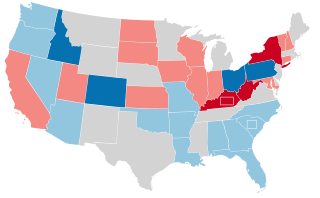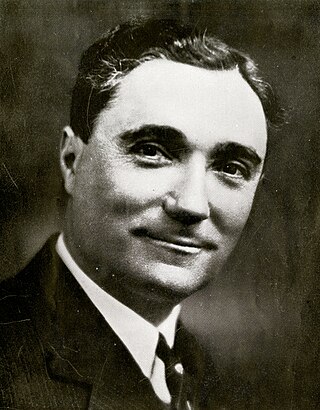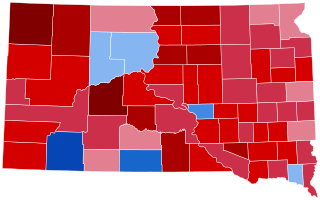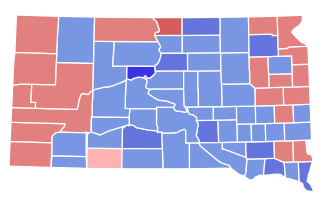
The 1956 United States Senate elections were elections for the United States Senate that coincided with the re-election of President Dwight D. Eisenhower. The 32 seats of Class 3 were contested in regular elections, and three special elections were held to fill vacancies. Although Democrats gained two seats in regular elections, the Republicans gained two seats in special elections, leaving the party balance of the chamber unchanged.

Walter Jeremiah Maddock was an American politician in North Dakota, US. He served in the North Dakota House of Representatives from 1915 to 1923, and became the 14th lieutenant governor of North Dakota in 1925. Maddock became the 15th governor of North Dakota in 1928 when Arthur G. Sorlie died in office. He was the first governor born in what would eventually become North Dakota.

George Frederick Shafer was an American politician who served as the 16th governor of North Dakota, serving from 1929 to 1932.

The 1932 United States Senate election in North Dakota took place on November 8, 1932. Incumbent Republican Senator Gerald Nye ran for re-election to his second term. He was challenged in the Republican primary by Governor George F. Shafer, but easily won renomination. In the general election, he faced P. W. Lanier, a 1930 Democratic congressional candidate. Even as Democrats were performing well nationwide, Nye had little difficulty winning re-election in a landslide.

The 2020 United States presidential election in North Dakota was held on Tuesday, November 3, 2020, as part of the 2020 United States presidential election in which all 50 states plus the District of Columbia participated. North Dakota voters chose electors to represent them in the Electoral College via a popular vote, pitting the Republican nominee, incumbent President Donald J. Trump from Florida, and running mate Vice President Michael R. Pence from Indiana against Democratic nominee, former Vice President Joe Biden from Delaware, and his running mate Senator Kamala Harris of California. North Dakota has three electoral votes in the Electoral College.

The 2020 United States presidential election in South Dakota was held on Tuesday, November 3, 2020, as part of the 2020 United States presidential election in which all 50 states plus the District of Columbia participated. South Dakota voters chose electors to represent them in the Electoral College via a popular vote, pitting the Republican Party's nominee, incumbent President Donald Trump, and running mate Vice President Mike Pence against Democratic Party nominee, former Vice President Joe Biden, and his running mate California Senator Kamala Harris. South Dakota has three electoral votes in the Electoral College.

The 1948 North Dakota gubernatorial election was held on November 2, 1948. Incumbent Republican Fred G. Aandahl defeated Democratic nominee Howard I. Henry with 61.33% of the vote.

The 1938 North Dakota gubernatorial election was held on November 8, 1938. Democratic nominee John Moses defeated Republican nominee John N. Hagan with 52.47% of the vote.

The 1936 North Dakota gubernatorial election was held on November 3, 1936. Nonpartisan League nominee William Langer defeated incumbent Republican Walter Welford with 35.80% of the vote.

The 1934 North Dakota gubernatorial election was held on November 6, 1934. Democratic nominee Thomas H. Moodie defeated Republican nominee Lydia Cady Langer with 52.98% of the vote.

The 1932 North Dakota gubernatorial election was held on November 8, 1932. Republican nominee William Langer defeated Democratic nominee Herbert C. DePuy with 54.75% of the vote.

The 1940 Iowa gubernatorial election was held on November 5, 1940. Incumbent Republican George A. Wilson defeated Democratic nominee John K. Valentine with 52.72% of the vote.

The 1930 North Dakota gubernatorial election was held on November 4, 1930. Incumbent Republican George F. Shafer defeated Democratic nominee Pierce Blewett with 73.62% of the vote.

The 1928 Washington gubernatorial election was held on November 6, 1928. Incumbent Republican Roland H. Hartley defeated Democratic nominee A. Scott Bullitt with 56.22% of the vote. This was the last gubernatorial election until 1980 in which a Republican carried Franklin County, Mason County, and Pierce County.

The 1916 North Dakota gubernatorial election was held on November 7, 1916. Republican nominee Lynn Frazier defeated Democratic nominee D. H. McArthur with 79.24% of the vote.

The 1914 North Dakota gubernatorial election was held on November 3, 1914. Incumbent Republican L. B. Hanna defeated Democratic nominee Frank O. Hellstrom with 49.58% of the vote.

The 1912 North Dakota gubernatorial election was held on November 5, 1912. Republican nominee L. B. Hanna defeated Democratic nominee Frank O. Hellstrom with 45.45% of the vote.

The 1910 North Dakota gubernatorial election was held on November 8, 1910. Incumbent Democrat John Burke defeated Republican nominee C. A. Johnson with 49.96% of the vote.

Elections were held in Illinois on Tuesday, November 3, 1936.

The 1928 South Dakota gubernatorial election was held on November 6, 1928. Incumbent Democratic Governor William J. Bulow ran for re-election to a second term. In the general election, he faced Attorney General Buell F. Jones, the Republican nominee. Despite Republican presidential nominee Herbert Hoover overwhelmingly defeating Democratic nominee Al Smith overwhelmingly in South Dakota, Bulow defeated Jones by a decisive margin to retain the governorship. In so doing, he became the first Democratic candidate for Governor to receive a majority of the vote in the state's history.























